Losing a limb is life-changing. It affects mobility, confidence, and everyday activities. But recovery is not just about healing physically—it’s also about rebuilding strength, confidence, and independence. One of the most powerful ways to do this is through adaptive sports.
Adaptive sports help amputees regain control of their bodies, improve balance, and boost mental health. They are modified versions of regular sports, designed to accommodate different abilities. Whether it’s running with a prosthetic leg, swimming with a specialized technique, or playing wheelchair basketball, these sports allow individuals to push their limits and rediscover what they are capable of.
More than just exercise, adaptive sports provide a sense of freedom. They create a space where amputees can compete, socialize, and feel strong again. The journey after amputation can be overwhelming, but engaging in sports can make rehabilitation faster, smoother, and more fulfilling.
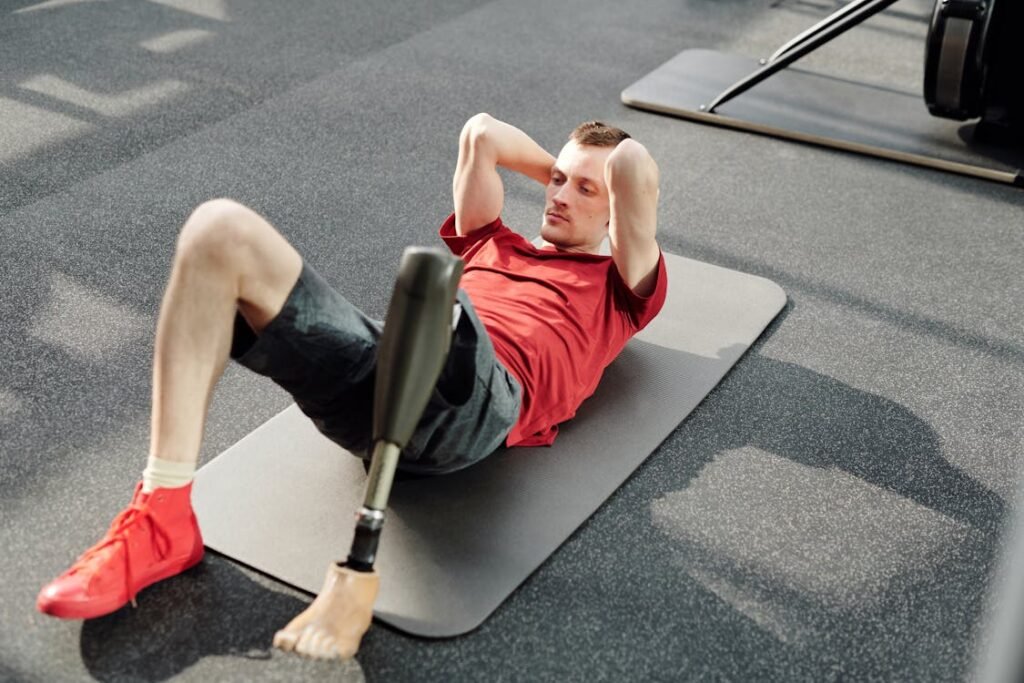
The Role of Adaptive Sports in Physical Rehabilitation
After an amputation, the body undergoes significant changes. Muscles that were once active become weaker, balance is affected, and movements that used to feel natural may now require conscious effort.
Adaptive sports help bridge this gap by encouraging movement, improving coordination, and strengthening muscles in a way that feels enjoyable rather than clinical.
One of the biggest challenges after amputation is regaining balance. Even with a high-quality prosthetic limb, the body needs time to adjust to a new way of moving.
Engaging in adaptive sports like swimming or cycling helps develop core strength, which is essential for maintaining stability.
The repetitive nature of these activities trains the body to adapt to its new center of gravity, making everyday movements like walking or standing much easier.
Cardiovascular fitness is another crucial aspect of rehabilitation. Many amputees experience a drop in overall fitness due to prolonged hospital stays and reduced activity levels.
Sports such as rowing or wheelchair basketball provide an excellent cardiovascular workout, helping to increase stamina and energy levels. This, in turn, makes daily activities less tiring and allows amputees to regain a sense of control over their bodies.
For those using a prosthetic limb, sports can be a game-changer in the adaptation process. Running with a prosthetic leg, for example, teaches the body to distribute weight evenly and move more efficiently.
Water-based activities like swimming allow amputees to move freely without worrying about weight-bearing, helping them build confidence in their movements. The more an individual engages in physical activity, the more natural their prosthetic limb begins to feel.
Enhancing Coordination and Mobility
The body and brain work together to create smooth, coordinated movements. However, after an amputation, the brain must learn new ways to send signals to the muscles. Adaptive sports encourage this process by challenging the brain and body to work together.
Sports that involve quick movements, such as wheelchair rugby or adaptive tennis, require hand-eye coordination, reflexes, and agility. The more an individual practices, the more refined these skills become.
This has a direct impact on daily life, making tasks like reaching for objects, climbing stairs, or even driving a car easier and more natural.
Water sports, such as kayaking or swimming, provide a low-impact way to improve mobility. The buoyancy of water reduces pressure on joints while still allowing for full-body movement.
This is particularly beneficial for individuals with lower-limb amputations, as it helps them strengthen muscles without the strain of weight-bearing activities.
Reducing Pain and Discomfort
Many amputees experience phantom limb pain or discomfort from using a prosthetic limb.
Engaging in sports has been shown to help manage these issues by increasing blood flow, reducing stiffness, and promoting the release of endorphins, which are the body’s natural painkillers.
Regular physical activity helps loosen tight muscles and joints, making it easier to wear a prosthetic comfortably for extended periods.
Sports that involve stretching and flexibility, such as adaptive yoga, can also be highly effective in preventing muscle tightness and improving overall comfort.
By incorporating adaptive sports into rehabilitation, individuals can regain strength, reduce discomfort, and improve overall mobility in a way that feels engaging and rewarding.
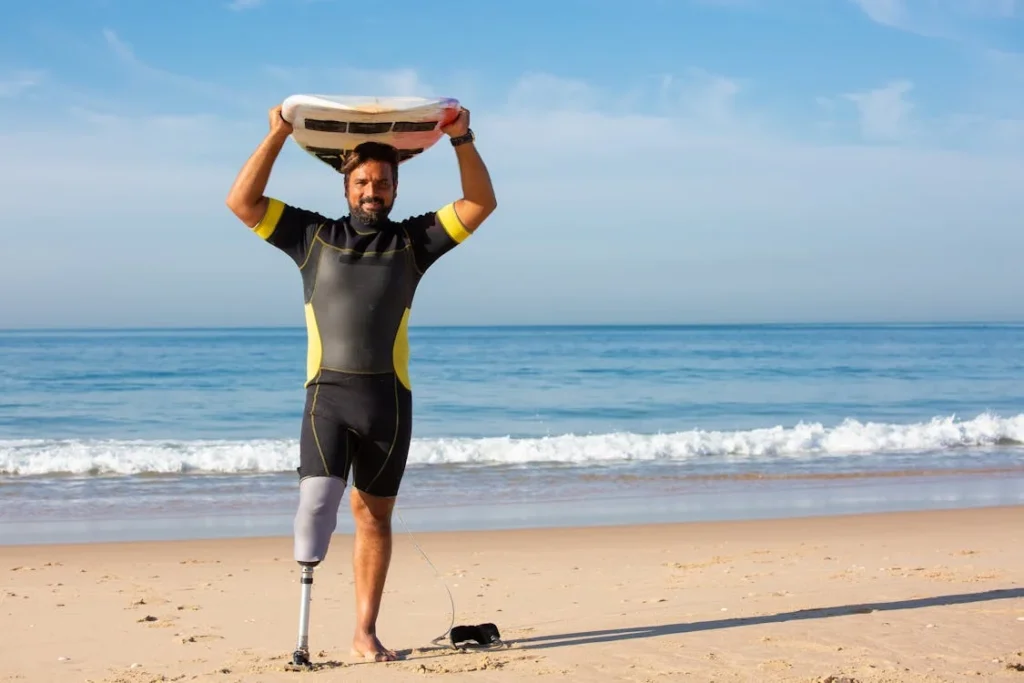
The Mental and Emotional Benefits of Adaptive Sports
Recovering from an amputation is not just about physical rehabilitation. The emotional and psychological impact is just as significant. Many amputees struggle with feelings of loss, frustration, and even isolation.
The sudden change in mobility and independence can take a toll on mental health. This is where adaptive sports play a transformative role—not just in rebuilding the body, but also in restoring confidence, motivation, and emotional well-being.
Overcoming Fear and Regaining Confidence
After an amputation, it is natural to feel hesitant about movement. Many people fear falling, injuring themselves, or simply struggling in public spaces.
Adaptive sports help break this cycle of fear by offering a safe and structured way to explore movement again. When an amputee realizes they can swim, run, or cycle despite their limb loss, it builds an incredible sense of self-belief.
Every small achievement in sports translates to real-life confidence. If an individual can balance well enough to play wheelchair tennis, they will likely feel more comfortable maneuvering in their daily environment.
If they can complete a long swim session, they may find walking for longer periods less intimidating. These experiences shift the focus from limitations to possibilities, empowering amputees to take on new challenges.
The Power of Community and Social Connection
One of the most overlooked challenges of amputation is social isolation. Mobility limitations, self-consciousness, or a lack of accessibility can make it difficult for amputees to participate in social activities as they once did.
This is why engaging in adaptive sports is so valuable—it creates a sense of belonging.
Being part of a team or training with other adaptive athletes provides a support system of people who truly understand the journey of recovery.
Many amputees find encouragement, friendship, and even mentorship in these communities. Seeing others who have overcome similar challenges can be deeply inspiring and motivating. It reminds individuals that they are not alone in their journey.
For many, sports become more than just a physical activity—they become a lifeline to friendships, shared experiences, and emotional support. Competing or training together fosters camaraderie and a sense of achievement that is often missing after a major life change.
Managing Stress and Mental Health
Exercise is a well-known stress reliever, and this is especially true for amputees.
The physical exertion of sports triggers the release of endorphins, which are chemicals in the brain that create a feeling of happiness and reduce stress. Many amputees who engage in sports report feeling more positive, less anxious, and more in control of their emotions.
Sports also provide a healthy outlet for frustration and emotional release. The rehabilitation process can be long and challenging, and it’s natural to feel moments of discouragement.
Physical activity provides a constructive way to cope with these emotions, whether it’s through the intense focus required in a game of wheelchair basketball or the calming rhythm of swimming laps in a pool.
By making adaptive sports a part of their routine, amputees can reduce stress, combat depression, and regain a sense of joy and fulfillment. It is a powerful reminder that life after amputation can still be full of excitement, challenges, and personal victories.
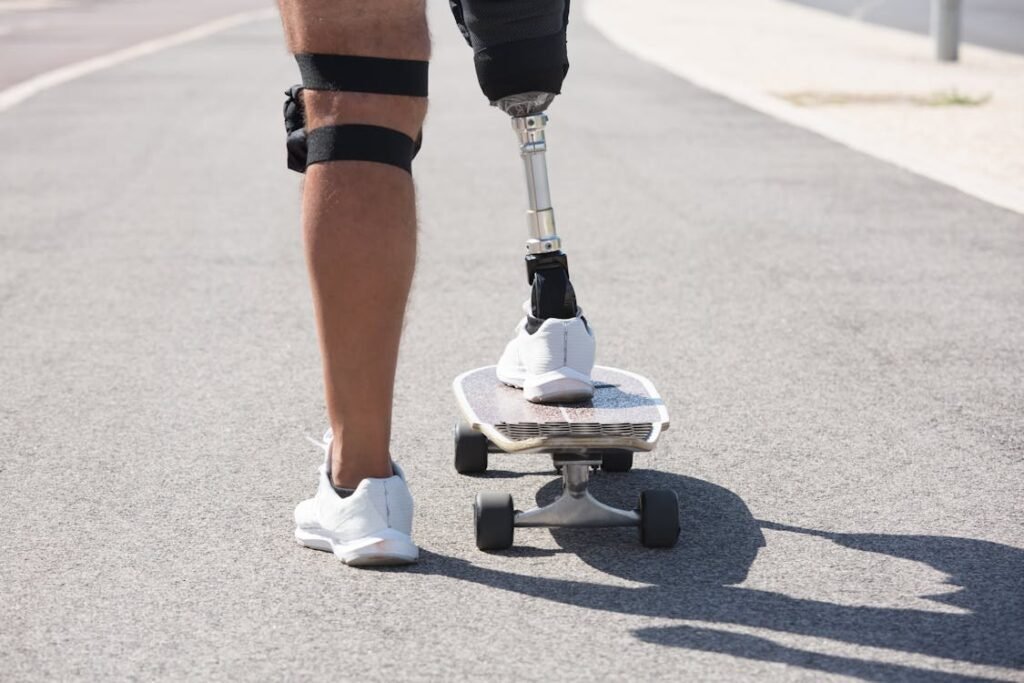
How to Get Started with Adaptive Sports
For many amputees, the idea of participating in sports again can feel overwhelming. Questions like “Where do I start?”, “What if I can’t keep up?”, or “Will I need special equipment?” are common.
The good news is that adaptive sports are designed to be inclusive and accessible, with options for all levels of ability. Whether someone is new to sports or was previously an athlete, getting started is easier than it seems.
Finding the Right Sport
Choosing a sport depends on several factors, including mobility level, personal interests, and rehabilitation goals.
Some people prefer solo activities like swimming or cycling, while others thrive in team sports like wheelchair basketball or amputee football. The key is to start with something enjoyable, as this makes it easier to stay motivated.
If the goal is to improve balance and coordination, activities like yoga, swimming, or seated volleyball can be beneficial. Those looking for cardiovascular endurance might explore rowing, running with a prosthetic blade, or wheelchair racing.
Each sport offers unique benefits, so it’s important to experiment and find the best fit.
Finding Local Programs and Support
The best way to begin is by looking for local adaptive sports programs. Many rehabilitation centers, prosthetic clinics, and sports organizations offer specialized training for amputees.
Connecting with these programs provides access to expert coaching, specialized equipment, and a supportive community.
In India, organizations like the Paralympic Committee of India and various non-profits promote adaptive sports at different levels.
Hospitals and physiotherapy centers often have resources or contacts for sports clubs that cater to individuals with disabilities. A simple online search or a discussion with a physiotherapist can provide valuable leads.
Working with a Prosthetist or Trainer
For those using a prosthetic limb, consulting with a prosthetist before starting a sport is crucial. Different activities require different types of prosthetic adaptations.
Running, for example, may require a specialized blade, while activities like rock climbing may involve adjustments for better grip and flexibility.
Physical therapists and adaptive sports trainers can also help with technique, ensuring that movements are safe and effective. Proper guidance reduces the risk of injury and speeds up the learning process.
Overcoming Initial Challenges
It is normal to feel hesitant in the beginning. The first few sessions may feel difficult, and adjusting to new movements takes time. However, progress comes with consistency.
Many athletes with limb loss report that their biggest breakthroughs happen when they push past early discomfort and self-doubt.
Starting slow and setting small, achievable goals can make a big difference. Whether it’s swimming one lap, standing with better balance, or completing a short run, each milestone builds confidence and motivation.
The body and mind will gradually adapt, making movements feel more natural over time.
Most importantly, having fun is key. Adaptive sports are not just about rehabilitation—they are about rediscovering joy, independence, and the excitement of movement. Once the initial fear fades, the possibilities are endless.
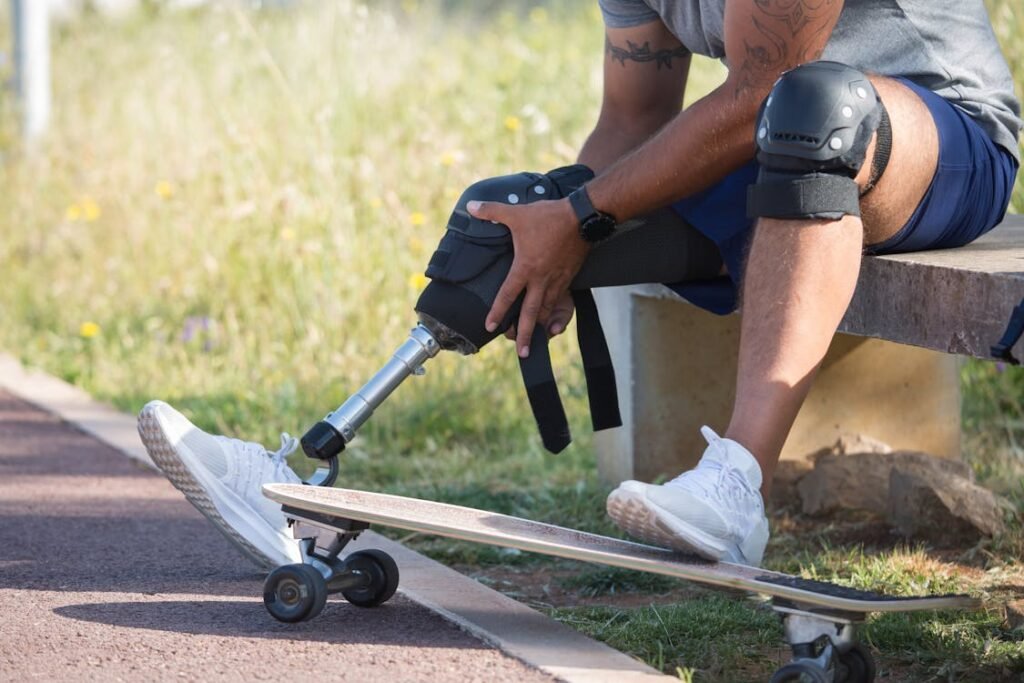
Long-Term Impact of Adaptive Sports on Life After Amputation
Engaging in adaptive sports is not just about short-term rehabilitation; it has lasting effects on an amputee’s quality of life.
Beyond improving physical strength and mobility, it plays a crucial role in fostering independence, self-esteem, and overall well-being.
Many who start adaptive sports as part of their recovery continue participating for years, transforming it from a rehabilitation tool into a lifestyle.
Boosting Independence and Daily Functionality
One of the greatest challenges after amputation is regaining independence in daily life. Simple tasks like walking, climbing stairs, or carrying objects can feel difficult at first.
However, participating in adaptive sports trains the body to move efficiently, improving balance, endurance, and coordination—all of which translate into better functionality in everyday activities.
For someone using a prosthetic limb, sports help develop muscle memory, making movement more instinctive. The more an individual engages in activities that challenge their mobility, the more natural daily tasks become.
Over time, they find themselves relying less on assistance and feeling more confident navigating the world on their own.
Career and Social Opportunities
The impact of adaptive sports goes far beyond physical health. Many individuals who engage in these activities find new career opportunities, whether in coaching, motivational speaking, or working in the adaptive sports industry itself.
Some even go on to compete professionally in national and international para-sports competitions, proving that limb loss does not have to be a barrier to success.
Additionally, being involved in sports fosters a sense of community, helping amputees build friendships and professional networks.
Socializing with teammates and coaches not only boosts confidence but also opens doors to new experiences and opportunities that might have seemed out of reach before.
Mental Resilience and Emotional Strength
The journey of amputation recovery requires mental resilience. There will be days of frustration and setbacks, but sports teach amputees how to push through challenges.
Training regularly instills discipline, patience, and perseverance—qualities that are invaluable in all aspects of life.
Competing, even in a friendly setting, builds emotional strength. The thrill of reaching a goal, the support of teammates, and the ability to overcome obstacles contribute to a positive mindset.
Adaptive athletes often report feeling stronger, not just physically but emotionally, because they have proven to themselves that they are capable of more than they once believed.
A New Perspective on Life
Perhaps the most profound impact of adaptive sports is the shift in perspective. Instead of focusing on limitations, amputees begin to see possibilities and potential.
They realize that life after amputation is not about what has been lost, but about what can still be achieved. This mindset can be life-changing, shaping a future that is not defined by disability, but by strength and determination.
Through sports, individuals reclaim control, confidence, and joy—proving that rehabilitation is not just about recovery, but about rediscovering the best version of oneself.
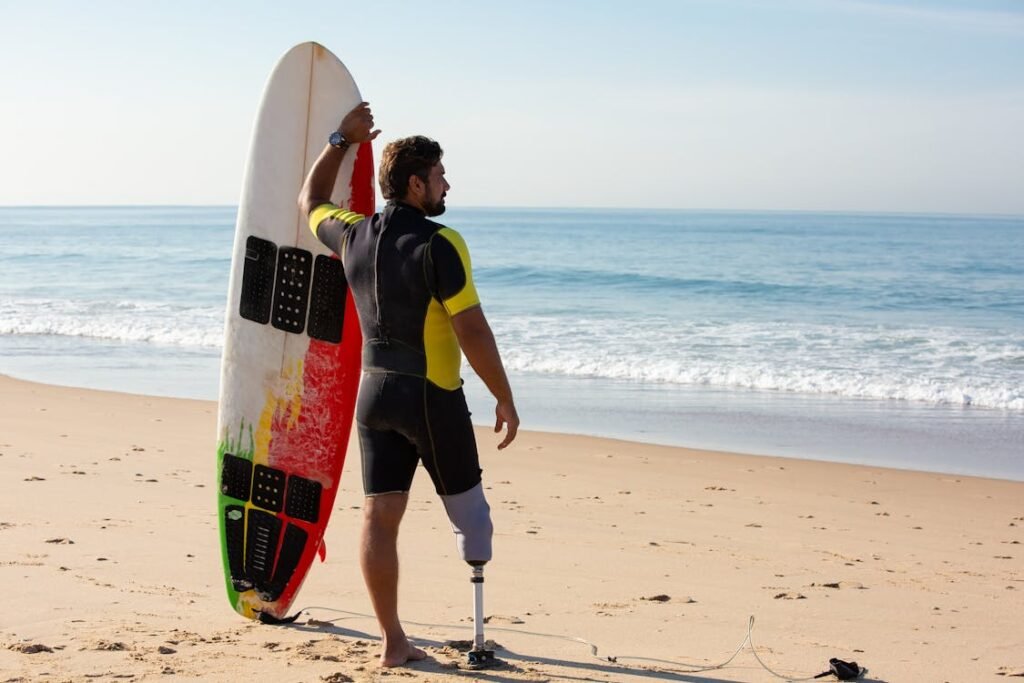
The Science Behind Adaptive Sports and Rehabilitation
The connection between sports and rehabilitation is well-documented. Scientific research has shown that physical activity accelerates recovery by stimulating muscle growth, improving circulation, and enhancing neurological adaptation.
When amputees engage in adaptive sports, they activate neural pathways that help the brain rewire itself to work with a prosthetic limb or compensate for missing limbs. This process, known as neuroplasticity, is key to faster and more effective rehabilitation.
How the Body Adapts Through Movement
After an amputation, the muscles surrounding the residual limb often weaken due to inactivity.
This can lead to imbalances, making daily movements like standing or walking more difficult. Adaptive sports help counteract this by strengthening core muscles and stabilizing the body.
Regular movement reduces muscle atrophy, improves blood circulation, and lowers the risk of complications such as joint stiffness or contractures.
Weight-bearing sports, such as running with a prosthetic leg, stimulate bone density, reducing the risk of osteoporosis—a condition that many amputees are prone to due to reduced mobility.
Even non-weight-bearing activities like swimming or rowing can have a profound impact on postural control and endurance, making everyday tasks easier and more natural.
Psychological Healing Through Sports
Beyond the physical benefits, engaging in sports helps rewire the brain emotionally. Many amputees experience phantom limb pain, where the brain continues to send signals to the missing limb.
Research suggests that engaging in movement-based activities reduces phantom pain by helping the brain focus on actual, controlled movements rather than missing sensations.
Sports also stimulate the production of endorphins, dopamine, and serotonin—neurotransmitters that regulate mood and combat anxiety and depression.
The repetitive nature of sports like swimming or cycling has a meditative effect, calming the nervous system and reducing stress levels.
Adaptive Sports for Different Types of Amputations
Every amputation is unique, and different sports cater to different levels of mobility. Whether someone has an upper-limb, lower-limb, or bilateral amputation, there are plenty of options available to suit individual needs.
Sports for Lower-Limb Amputees
For individuals with below-knee or above-knee amputations, sports that focus on balance, endurance, and agility can be highly beneficial.
Running with a prosthetic blade, cycling, or wheelchair racing helps develop leg strength, improve cardiovascular fitness, and enhance proprioception (awareness of body position).
Water-based activities like swimming are particularly useful because they allow amputees to move freely without weight-bearing pressure, reducing joint strain while improving overall fitness.
Adaptive skiing and rock climbing are also excellent options, as they help with coordination and stability.
Sports for Upper-Limb Amputees
For those with upper-limb amputations, the focus shifts to hand-eye coordination, upper-body strength, and dexterity.
Wheelchair basketball and tennis offer fast-paced, high-intensity workouts that help develop arm and shoulder muscles. Rock climbing, kayaking, and rowing are excellent for improving grip strength and endurance.
Modified weightlifting and resistance training are also essential, as they help amputees strengthen the muscles surrounding their residual limb, improving functionality in daily life.
Many athletes use customized prosthetic attachments, such as hooks or adaptive grips, to enhance their performance.
Sports for Bilateral Amputees
For individuals with bilateral limb loss, sports like wheelchair rugby, swimming, and cycling provide full-body workouts that improve cardiovascular health, strength, and coordination.
With advances in prosthetic technology, even high-impact sports like paralympic sprinting and archery are now accessible to bilateral amputees.
Overcoming Mental Barriers to Participating in Sports
One of the biggest obstacles that amputees face when considering adaptive sports is self-doubt. Many worry about being unable to keep up, feeling uncomfortable in public settings, or struggling with the physical demands of the activity.
These fears are natural—but they can be overcome.
Shifting Mindset from Limitations to Possibilities
The first step in embracing sports is changing the way the mind perceives challenges. Instead of focusing on what seems difficult, amputees can start by setting small, achievable goals.
Walking for longer distances, balancing for extended periods, or improving flexibility are all victories that build confidence over time.
Training with others who have experienced similar challenges can be incredibly motivating. Seeing fellow amputees succeed serves as a powerful reminder that limitations exist only in the mind.
Adaptive sports communities are built on support, encouragement, and shared triumphs.
Dealing with Frustration and Setbacks
Like any form of rehabilitation, progress in sports is not always linear. There will be days of frustration, muscle soreness, and moments when it feels like things are not improving.
However, each challenge is part of the journey. Every great athlete—adaptive or not—has faced setbacks. The key is to stay patient, adjust expectations, and keep moving forward.
Rehabilitation is not about perfection; it’s about persistence. The more one practices, the more comfortable and confident they become. Over time, movements that once felt impossible become second nature.
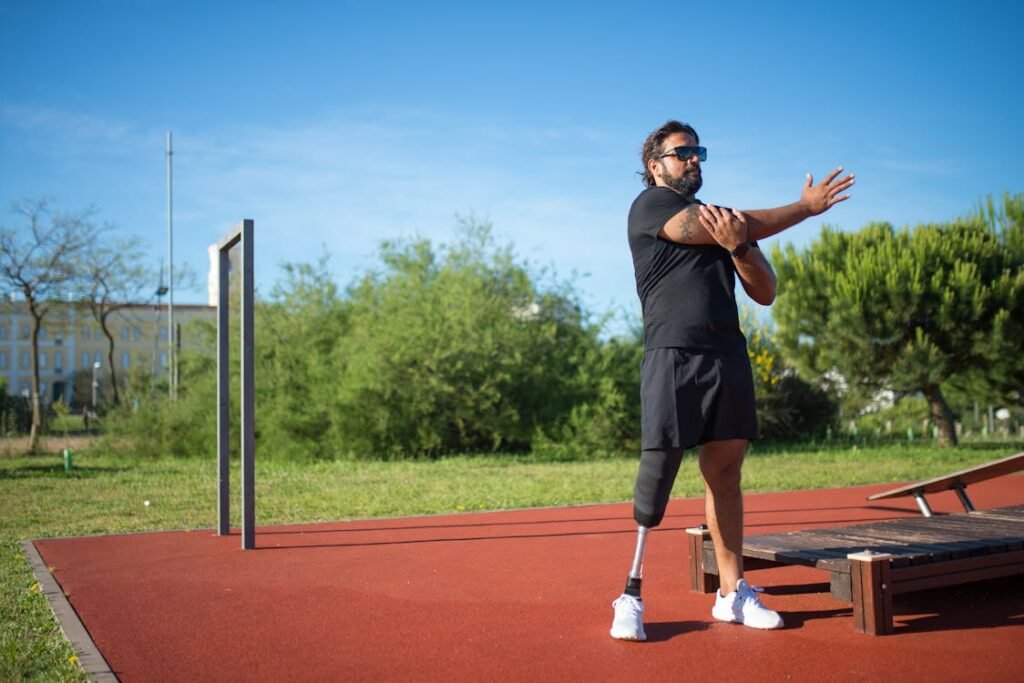
The Role of Technology in Adaptive Sports
Advancements in prosthetic technology have opened up a world of possibilities for amputees in sports. Cutting-edge designs like bionic hands, running blades, and multi-grip prosthetics have revolutionized the way individuals engage in physical activities.
High-Performance Prosthetic Limbs
Modern prosthetic limbs are designed for specific sports, enhancing performance and comfort. Running blades, for example, are made from lightweight carbon fiber, allowing for maximum speed and flexibility.
Prosthetic arms with advanced grip control enable athletes to lift weights, climb, and even play musical instruments.
Smart Prosthetics for Better Mobility
Some of the latest prosthetics come with built-in sensors and AI-driven technology, helping users adjust their movements in real time. This is particularly useful for activities that require quick reflexes, such as adaptive soccer or cycling.
At Robobionics, we believe in harnessing technology to improve the quality of life for amputees. Our Grippy™ bionic hand is designed to offer enhanced control and functionality, making it easier for users to engage in everyday tasks and sports.
How to Stay Motivated in Adaptive Sports
Maintaining motivation in any sport requires passion, consistency, and a supportive environment. Adaptive athletes often find that setting personal challenges—such as running a set distance, improving endurance, or competing in a local event—keeps them engaged.
Celebrating small wins is important. Whether it’s balancing better, increasing strength, or learning a new technique, every milestone counts. Surrounding oneself with a community of like-minded individuals—coaches, teammates, and mentors—provides encouragement and accountability.
Joining adaptive sports events, charity runs, or friendly competitions can also add an extra layer of excitement. Nothing compares to the feeling of crossing a finish line or achieving a goal after months of training.
Conclusion
Adaptive sports are far more than just a form of exercise—they are a powerful tool for transformation. They help amputees regain physical strength, improve mobility, and build confidence, all while providing a sense of purpose and belonging. What begins as part of rehabilitation often becomes a lifelong passion, opening doors to new challenges and achievements.
For many amputees, the journey after limb loss feels uncertain. But engaging in adaptive sports replaces fear with strength and hesitation with progress. Every practice session, every movement, and every breakthrough reminds them that they are capable of far more than they imagined. The body adapts, the mind grows stronger, and a new sense of independence emerges.
At Robobionics, we believe in empowering individuals to live life without limitations. Whether it’s through advanced prosthetics like Grippy™, home-based rehabilitation programs, or encouraging users to explore adaptive sports, our goal is to help amputees lead active, fulfilling lives. If you or a loved one is navigating life after amputation, know that the possibilities are endless—and we are here to support you every step of the way.



